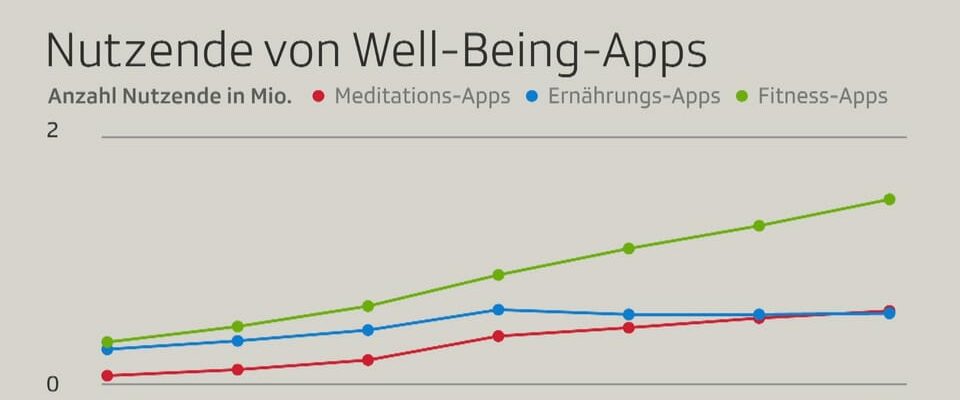Contents
A new study asks about the connection between the use of wellness apps and mental well-being.
How frequently are wellness apps used? For what purposes are they most commonly used? What is the connection between using wellness apps and mental well-being? A new study from the Graubünden University of Applied Sciences investigates these questions.
According to the study, wellness apps are most often used to monitor health data such as heart rate, step count and sleep duration: 19 percent of those surveyed use them daily, 21 percent use them once or several times a week. They are followed by apps to improve mood and apps to increase physical activity: Seven percent of those surveyed use them daily, 19 percent use them once or several times a week. Apps for meditation and recording habits and moods are used the least.
Legend:
SRF
Christian Hauser, co-author and professor of business administration at the Graubünden University of Applied Sciences, says that the number of downloads of wellness apps has boomed in recent years. They skyrocketed, especially during the Corona period. And: “Especially around the turn of the year, these apps are in greater demand because people want support.”
The most popular, says Hauser, are apps for counting steps, measuring heart rate and monitoring sleep.
Heavy users fare less well
The study authors divided the respondents into frequent and infrequent users. Frequent users are, among other things, younger, more likely to work full-time, live more in cities and have a higher level of education than occasional users. According to the study, the two groups differ most in the frequency with which they use apps to improve their sleep, reduce stress and non-illness-related anxiety, and increase their physical activity. The study comes to the conclusion that heavy users have lower mental well-being on the well-being scale (23.6 points out of 35) than light users (26.6).
Christian Hauser sees two possible explanations: “Either people have poorer mental well-being from the start and are trying to improve their well-being. But that doesn’t work.” The second explanation is also supported by studies: “If we spend a lot of time using digital tools, our mental well-being decreases.” Too much movement in digital rather than real space is bad for your mental well-being.
It depends on the match
Ursula Meidert, health sociologist at the Zurich University of Applied Sciences, has studied wellness apps in detail. She says it really depends on whether an app really suits the person using it: “There needs to be a match between what I expect from an app and what it brings me.” And: “There are better apps in terms of quality in the sense that they use methods that we know from normal therapies to work.”
Meidert has examined apps that have been proven in studies to work. They showed that the symptoms of stress can be reduced, that people were able to concentrate and sleep better and were more motivated at work: “Most of the apps were developed from programs that are also available offline,” says Meidert.
